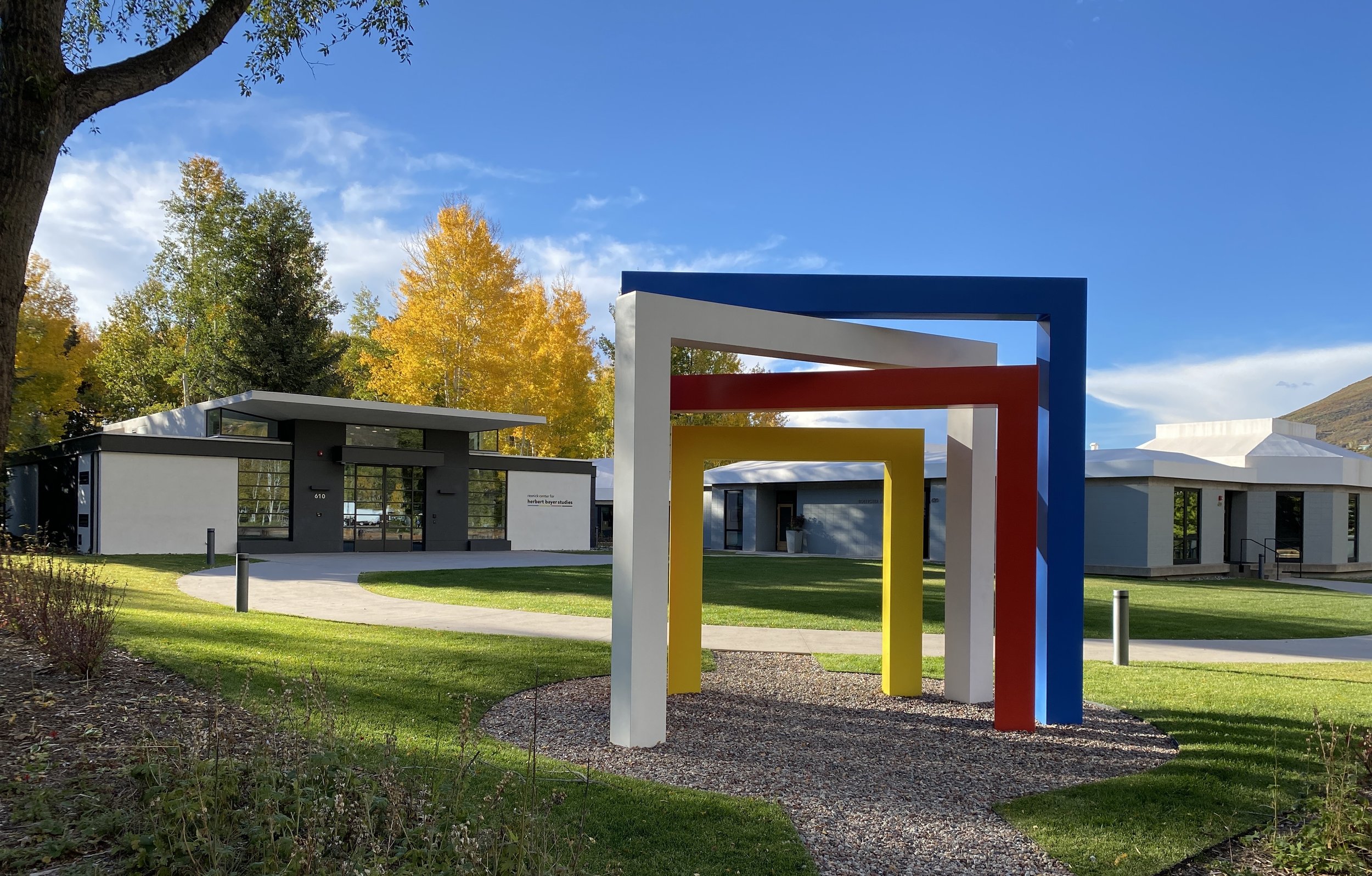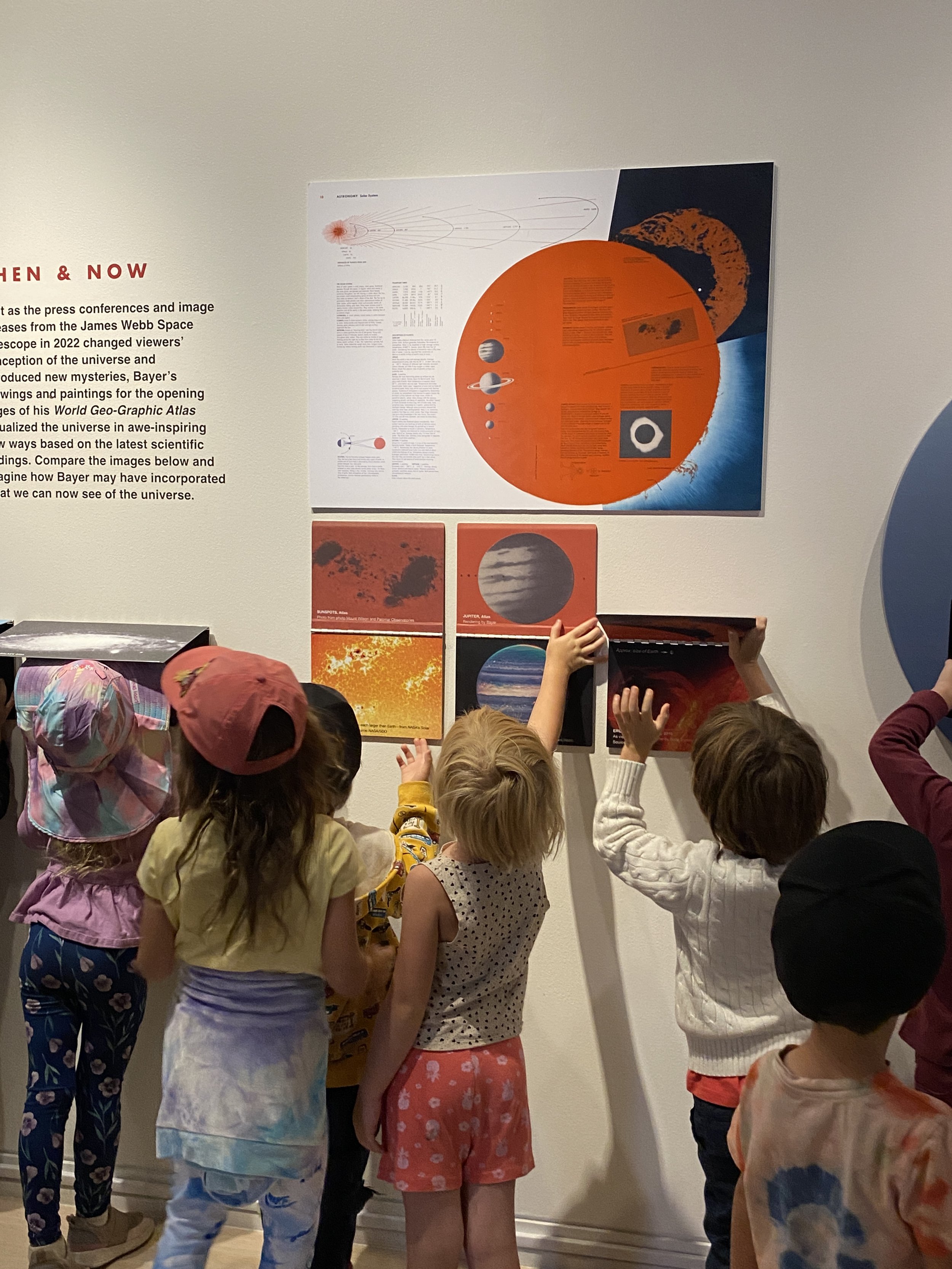I had the opportunity to interview singer, songwriter, composer, radio personality, MacArthur Genius, and multiple Grammy winner Chris Thile in advance of his performance at the Aspen Music Festival. Read more of my interview here in Festival Focus. His performance was every bit as witty, energetic, and engaging as the interview.
My Day Job
In 2022, the Resnick Center for Herbert Bayer Studies opened its doors on the campus of the Aspen Institute. Soon after, I was part of the ‘freshmen class’ of Bayer Center employees, doing everything from giving tours and talking to visitors, to fixing toilets and changing water filters. What started as a post-Covid desire to return to some normalcy in an engaging setting with other people has quickly morphed into a position as Communications Manager.
The Bayer Center is an art space dedicated to preserving the legacy of the Austrian-born artist and designer Herbert Bayer (1900–1985), who studied and taught at the Bauhaus before emigrating from Germany to the United States in 1938. Between 1946 and 1975, Bayer was instrumental in Aspen’s postwar revitalization, designing the Institute’s Aspen Meadows campus and shaping the organization’s early aesthetic and programmatic vision.
Our goal at the Bayer Center is to promote a more complete understanding of Bayer—one of the leading figures to translate the Bauhaus movement into an American context—and his contributions to art, design, and architecture. For me, it’s a return to utilizing my degree in Art History, and it’s a chance to dig a bit deeper into Aspen’s unique history and the role that art, design, culture, and commerce played in making it the highly sought-after destination it is today.
A Celebration of Jewish Composers
Composer and conductor James Conlon has made it his mission to highlight and bring to audiences music that was suppressed under the Nazi regime, either because the composers were of Jewish descent or, in some cases, lost in concentration camps. Read here about his Recovered Voices project, which was performed on July 26 in the Benedict Music Tent.
Aspen Music Festival Focus: Family Mariachi Celebration
The second annual three-day Mariachi Workshop and free community concert was a huge success for the 85 middle and high school students who worked alongside a team of statewide mariachi teaching specialists, learning performance techniques and how to play traditional instruments like the guitarron and vihuela. Read more about it here.
Festival Focus - Week Two
One of the things I love about writing these short pieces is the opportunity to interact with the artists. Mexican pianist Jorge Osorio is no exception. Here, he talks about his long collaboration with AMFS Music Director and Conductor Robert Spano and his love of Beethoven.
Focus on the Aspen Music Festival - Week 1
Happy Independence Day!
Even though I’m now the Communications Manager at the Resnick Center for Herbert Bayer Studies, I can’t give up the opportunity to interview wonderful musicians and composers for the Aspen Music Festival.
Week 1 features arguably the greatest living string player performing today, Maxim Vengerov, in concert with beloved British conductor Nicholas McGegan performing Schubert and Mendelssohn. Read about it here!
Seize the Day!
Just as the calendar turns the corner on the long days of summer toward the autumnal equinox, a verdant and glorious wildflower explosion is happening in the high country. This summer, above average temperatures coupled with unusually early monsoon moisture have sent the wildflowers into a frenzy, their beauty indomitable but fleeting. From the miniscule spotted saxifrage mounding delicately over rock outcroppings in the tundra to the robust green gentian—also appropriately known as monument plant because it can grow over 6 feet tall—each plant is having its moment in the sun. They know their time is short and they’re making the most of it.
A recent trip to a windswept 11,000’ mountain deep in the heart of the Flat Tops revealed summer in its full glory, suggesting that mid-summer in the Rocky Mountains might just be the most wonderful time of the year. Located a few thousand feet above the arid, south-facing slopes of the Colorado River valley are millions of acres of verdant green forest interspersed with wildflower meadows, overflowing with sky pilot, scarlet gilia, varieties of paintbrush and penstemon, and sticky geranium. Dense stands of mountain bluebells, sprinkled with bistort, monkshood, buttercups, and elephant head announce the presence of water—both standing and moving—in the rocky terrain. Pockets of plump Rocky Mountain columbine stand side-by-side with shoulder-high cow parsnip deep in the aspen forest. In the crevices of sheltered rocks, yellow stonecrop (an alpine succulent) coexists with mountain thistle (the good kind) and a variety of saxifrage. Basking in the meltwater from the few remaining snowbanks are carpets of purple violets. Observant hikers might even chance upon a singular glacier lily, its golden yellow flower hanging precipitously beneath an arching stem. At the top of the peak, hearty clumps of purple phacelia intermix with abundant perennial grasses.
Sharp cries announce the busy pikas, whose scurried movements amongst the boulders suggest they are already packing their dens with grass hay, seeds and other delectables for the long winter ahead. Marmots sun themselves on rock outcroppings, while butterflies and bees attend to business in the bustling cacophony of color. The flies it seems, have time to rest in between their own pollination spree. Their tiny bite is a distinct reminder of who’s boss, even at 11,000 feet.
A trip to the top of Vail Pass yields equally splendid vistas of wildflowers this time of year. Along Shrine Pass, varieties of paintbrush and lupine are in full bloom. A more secluded hike up 12,200’ Uneva Peak passes through a pine forest before ascending into the land above the trees where low-growing hearty alpines thrive amongst the talus fields, tundra turfs, and wet meadows.
Wildflower displays continue to evolve with the advent of afternoon rain showers during late July and August. Asters (of which there are an endless variety) intemix with the golden blooms of goldenrod, sneezeweed and showy goldeneye. Gentians, too, dot the landscape, their flowers closing with changing nighttime temperatures and frequent thunderstorms. Interestingly, the gentian’s unique ability to protect itself against the elements increases seed production up to 70 percent compared to flowers that remain open.
For a more in-depth look at alpine plants of Colorado and the world, visit Betty Ford Alpine Gardens. As the sole keeper of the nation’s exclusive collection of Colorado’s alpine flora, the Gardens is actively engaged in conservation of alpine plants from around the world. Included in the Colorado alpine collection are rare and endangered species endemic to the state, including the Parachute penstemon, an unusual plant that grows only in oil shale talus along steep cliffs in western Colorado, and the Hoosier Pass ipomopsis, a member of the phlox family that is found only above 10,000 feet in the Mosquito Range.
This piece was published in the Vail Daily on July 23, 2022.
What Do You Know About Wilderness Protection?
For most people, wilderness connotes wild, untouched, untrammeled, and remote places. Some find spending time in wilderness areas enriching and spiritually uplifting. These are the people who disappear into the backcountry for days or weeks on end, savoring the solitude that surrounds them. Others find the entire concept scary. It’s the same feeling I get when I swim in the ocean: the terror of what’s circling in the dark waters below me so consumes my psyche that swimming becomes secondary to survival.
The Wilderness Act of 1964 defines wilderness as “an area where the earth and its community of life are untrammeled by man, where man himself is a visitor who does not remain.” Its purpose is to preserve and protect the natural ecosystems and wild areas, while also providing opportunities for solitude and retrospective or primitive recreation.
Today, there are 765 wilderness areas covering more than 109 million acres. And, while that number should suggest broad public engagement in wilderness protection, 80% of the current population was not born when the Wilderness Act was passed!
Interestingly, not all wilderness areas are whole. In fact, in our lower 48 states, approximately 180,000 acres of private inholdings remain within federally designated wilderness areas. These parcels, which range in size, are ripe for development particularly if they are also accessible. Who’s to stop someone from building a mega-mansion in the middle of a wilderness area, or deciding a mining claim should be exploited?
That’s where The Wilderness Land Trust comes in. For 30 years, TWLT has been acquiring unprotected private land within designated wilderness and returning it to public ownership. With 55,200 acres permanently protected and 523 parcels of formerly private land now under public ownership, the Trust’s work is felt far and wide due to its successful removal of real and present development threats. As a result of the Trust’s tenacity, more than 17 million acres of wilderness remain intact, a number that truly explains its broad impact on national and global conservation strategies.
Celebrate the Trust’s 30th birthday by learning about its first 30 years here. I’d love to know what wilderness means to you, and how we can continue to attract a new generation of wilderness lovers.
The Sound of Music comes into Focus
I’m dipping my toe into writing about music this summer. Here’s the first of my pieces for Festival Focus, the weekly classical music guide for the Aspen Music Festival and School. How lucky am I to write about one of my most favorite musicals ever? Playing the role of Maria is Christy Altomare, who is truly delightful and a bright spot on stage. I saw her perform in AMFS’s production of South Pacific a few years ago, but here’s the piece that reminded me of what a talent she truly is.






